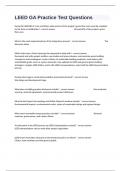LEED GA Practice Test Questions
Except for LEED BD+C: Core and Shell, what percent of the project's gross floor area must be complete
by the time of certification? - correct answer At least 60% of the project's gross
floor area
What is the most important phase of the integrative process? - correct answer The
discovery phase
Which tasks may a Green Associate be requested to help with? - correct answer
Document and write project profiles, case studies and press releases; communicate green building
concepts to team/colleagues; create a library of sustainable building materials; assist others with
sustainability goals; serve as a green advocate; stay updated on LEED and general green building
strategies; navigate LEED Online; assist with LEED correspondence; assist with the LEED documentation
process
During what stage is construction pollution prevention planned? - correct answer
Site design and development stage
What does a building product disclosure include? - correct answer Raw materials
sourcing, material ingredients, environmental product disclosure
What do the Project Surroundings and Public Outreach sections include? - correct answer
Environmental impacts, environmental codes, values of sustainable design and regional design
What must renewable energy practices consider? - correct answer Demand
response, green power, and carbon offsets
At what point in the LEED process are LEED Interpretations created? - correct answer
LEED Interpretations can be made after project registration
LEED Green Associates advocate environmental practices to whom? - correct answer
Clients, team members and the general public
,Which standards support LEED? - correct answer American Society of Heating,
ASHRAE, SMACNA guidelines, Green Seal, Energy Star, HERs
In the site design and development stage, what should be considered? - correct answer
Construction activity pollution prevention, habitat conservation and restoration, exterior open space,
rainwater management, exterior lighting, heat island reduction
What types of building spaces are considered in the energy and atmosphere credit category? - correct
answer Private offices, individual space, shared multi-occupant spaces
What types of reuse are considered in the materials and resources credit category? - correct answer
Building reuse, material reuse, interior reuse, furniture reuse
What types of waste are considered in the materials and resources credit category? - correct answer
Construction and demolition, maintenance and renovation, operations and ongoing
Which codes are applicable to LEED buildings? - correct answer Building, plumbing,
electrical, mechanical, fire protection, green building
How can indoor air quality be improved? - correct answer Managing ventilation
levels, tobacco smoke control, use of low-emitting materials, green cleaning practices
Regional emphasis should be placed on which credit categories? - correct answer
Sustainable Sites, Materials and Resources
What does commercial construction in the United States account for? - correct answer
14% of potable water consumption, 30% of waste output, 38% of CO2 emissions, 40% of raw material
use, 24 - 50% of energy use and 72% of electricity consumption
What are the recommended steps for devising a LEED work plan? - correct answer
(1) Initiate discovery phase, (2) Select LEED rating system, (3) Check minimum program requirements,
(4) Establish project goals in a goal-setting workshop, (5) Define LEED project scope and boundary, (6)
Develop the LEED scorecard and determine target certification level, (7) Continue the discovery phase,
, (8) Continue iterative process, (9) Assign roles and responsibilities, (10) Develop consistent
documentation and track ongoing progress, (11) Perform quality assurance review and submit for
certification
What are some of the most common special project situations? - correct answer
Mixed Use - Possible to use other rating systems for certain credits; Multi-tenant Complex; Incomplete
Spaces - Requires supplemental letter of commitment or nonbinding tenant guidelines; Projects with
several physically distinct structures - Project must be analyzed as a whole
Does the development footprint include semi-permeable paving? - correct answer
Pavement that is at least 50% permeable is excluded from the development footprint
Is land that has been voluntarily excluded from development considered buildable land? - correct
answer Yes, land set aside voluntarily for open space is considered buildable land
How do density calculations vary based on whether a project is residential or non-residential? - correct
answer Residential projects calculate density as the number of dwelling units
divided by residential land area, while non-residential projects use the floor area divided by the
buildable land area (FAR); Combined density for residential and non-residential areas uses FAR
How do most credits group building occupants? - correct answer Regular building
occupants and Visitors
Who is considered to be a regular building occupant? - correct answer Employees,
Regular Volunteers, Residents, Primary and Secondary School Students, Hotel Guests, Inpatients
Who is considered to be a visitor? - correct answer Retail Customers, Outpatients,
Periodic Volunteers, Higher Education Students (except for dorms)
How do building occupancy calculations vary between regular and transient occupants? - correct answer
Occupancy with regular building occupants is measured in FTE's (Full-Time Equivalent), while visitor
occupancy is expressed as daily averages and daily peak totals




